Intro
The following article gives a basic overview of Association Croquet (or simply "croquet") and is aimed at those who have not played before. As such it does not go into low-level detail. This site has further sections which explore various facets of the sport in much greater detail, but if you are new to the game then this is the place to start.
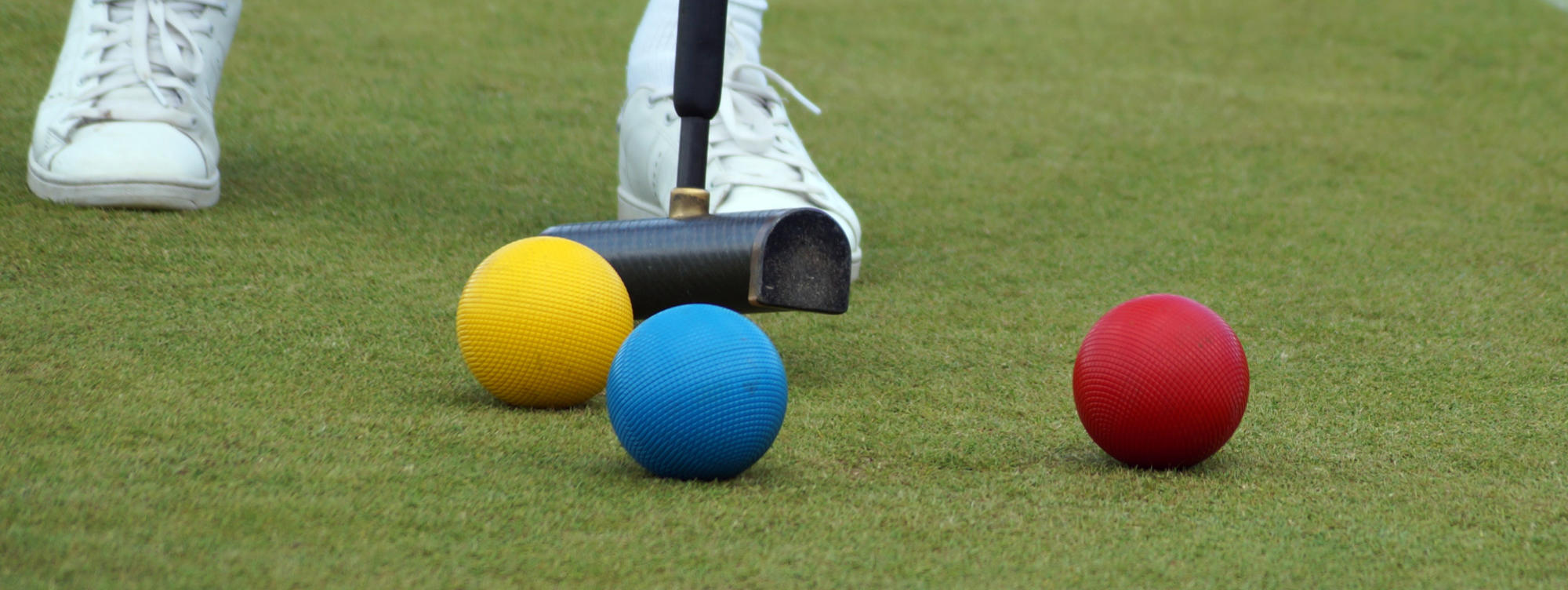
Association Croquet is a mallet sport often likened to a cross between snooker and golf. It is played on equal terms between men and women, and between players of all ages. There is also a robust handicapping system used in croquet (as with golf) meaning that a handicap game can be enjoyed between players with vastly differing abilities. As with other sports such as tennis, croquet can be played as either singles or doubles. Croquet requires a good ability to think under pressure and a certain amount of physical and mental fitness - each game may last between 30 minutes and 3 hours (and sometimes longer) and in major events these are usually played as best-of-3 or best-of-5 games.
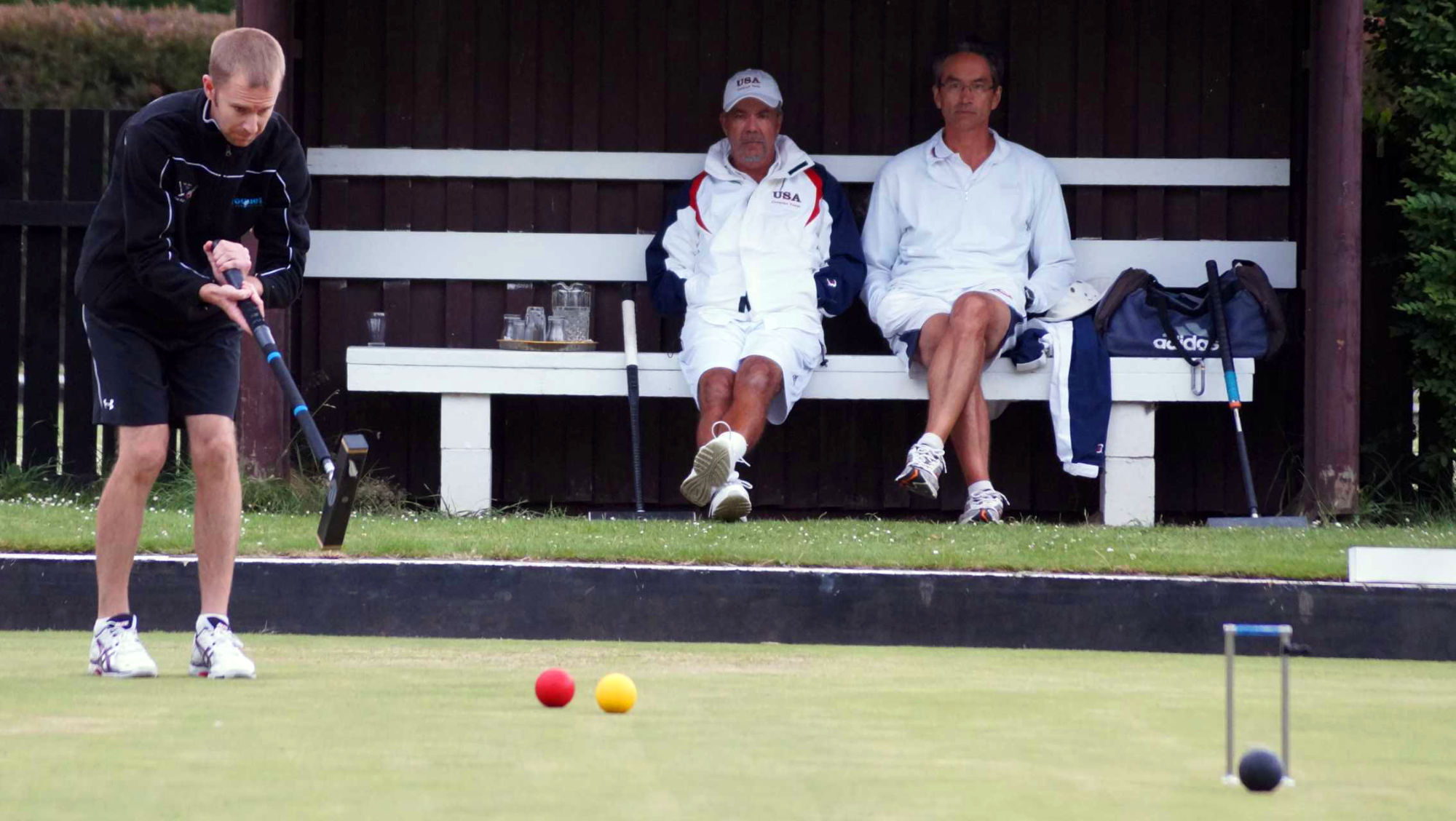
There are national croquet federations recognised by the World Croquet Federation (WCF) in 29 countries around the world, and there is a very strong competitive croquet scene in a number of these countries. The WCF organises numerous world championship events, both for teams and individuals - the most famous event is probably the MacRobertson Shield, which is a 4-yearly team event for the 4 strongest croquet-playing nations (New Zealand, Australia, England and the USA). The shield has been competed for since 1925 and comprises one team from each country, each comprised of the 6 best available players from that country. In addition to this, there are both 'Open' and 'Womens' world championships organised by the WCF, and all the major croquet-playing nations also hold national events in various categories. As well as national events, there are regional and inter-club tournaments, and of course local club championships at most croquet clubs.
The game
The game itself is a contest between two sides - one playing the blue & black balls, and the other playing the red & yellow balls. The basic objective is to score 26 points with your balls before your opponent does with theirs. A single point is scored by hitting one’s ball through a hoop. The hoops are numbered and must be scored in a specific order. In order to play most effectively, it is best to try and score several hoops in one turn (known as "playing a break") - this is where the snooker comparison comes in. Unlike snooker, however, it is impossible to finish a game in one single turn without giving your opponent any chance - this is because in croquet each side has 2 balls, and upon the start of a player's turn they must decide which ball they want to play with for the duration of that turn. While it is possible for Player A to score all of the hoops for one of their balls in a single turn, the turn must come to a stop at some point in order for Player B to play their turn, before the Player A can have another opportunity to score points with their second (or "partner") ball. Play at the expert level often involves a player scoring points with one of their balls while also manoeuvring the other balls around the court to specific positions in order to cause their partner ball to travel through some of its own hoops (called "peeling").
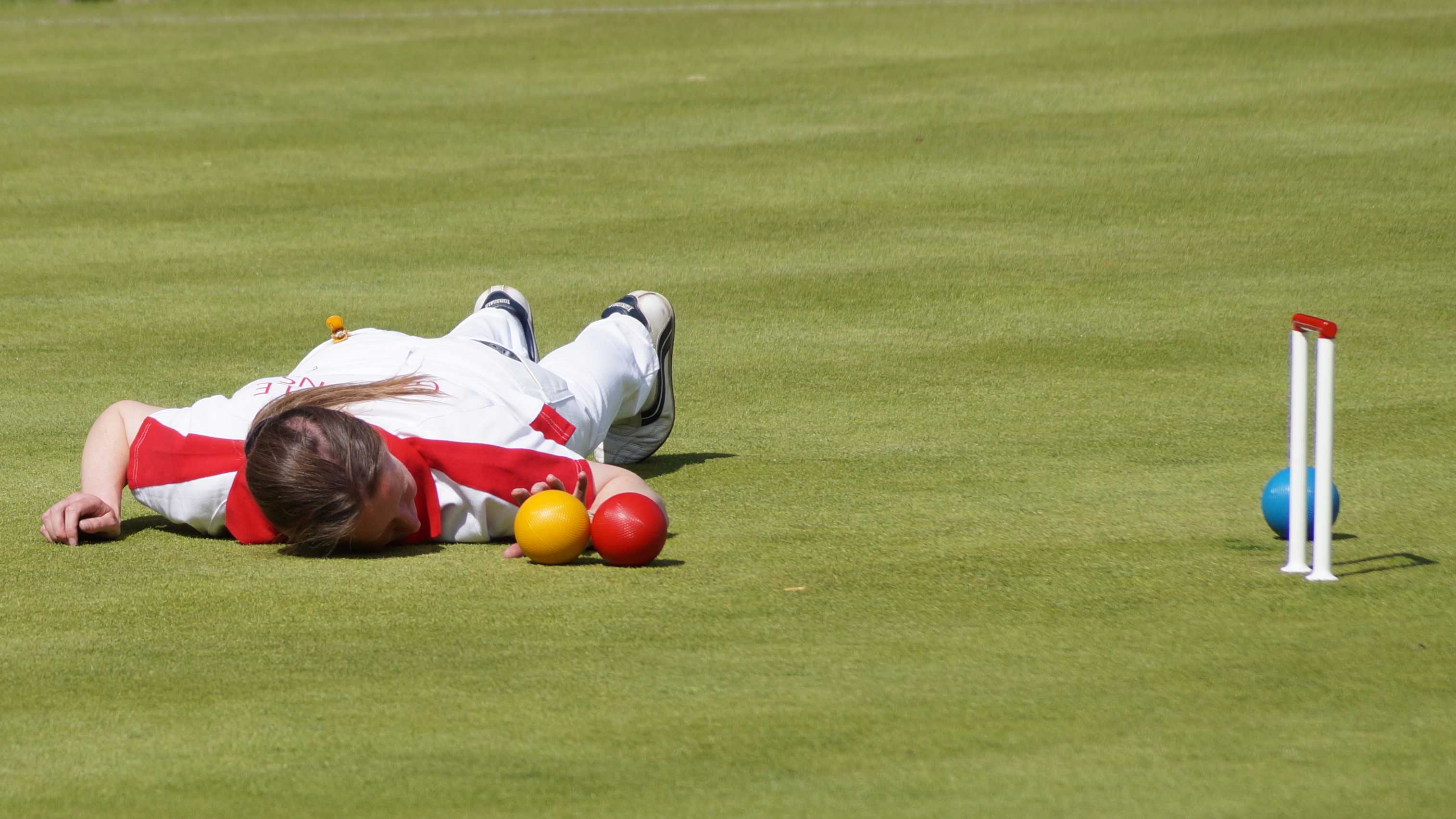
You win a game of croquet by hitting your balls onto the peg - this is called a pegout. This can only be done after each of your balls has scored all of its hoops.

The Court
There are 6 hoops, numbered "1" through to "6" at fixed positions around the court, plus a "peg" in the very centre of the court. In order to score 26 points, you must run each of your balls through each of its hoops in the correct order twice (once in each direction) and then hit both your balls onto the peg in the middle. The hoops "7" through to "12" are not named as such, with hoop 7 being called "1-back" and so on, as you can see on the diagram below,
Turns and Shots
The game starts off with the toss of a coin and the winner of the toss is allowed to decide whether to play first or second, or may instead choose which colours to play with. The balls are initially played into the game from either of the two 'baulk' lines (measured in exactly 1 yard from the white line), and once all the balls are in the game, the player when beginning their turn can elect to play with either ball. Each turns consists initially of only one shot. With this shot, if you fail to hit your ball onto another ball, or fail to score your current hoop, then that is the end of your turn.
However, it is possible to extend your turn to multiple shots - sometimes many dozens - the following rules apply:
- Make a roquet - a roquet is when you hit your ball onto another ball - doing so will earn two extra shots
- Score a hoop - hitting your ball through its current hoop - doing so will earn one extra shot
Let's look at these in more detail:
Making a roquet
Hitting your ball onto another ball is one of the fundamentals of croquet. At the start of every turn, with your ball you are allowed to "roquet" each of the other balls once.

Every time you make a roquet, you will earn two extra shots - these extra shots cannot be accumulated and saved to be used later; they must be played immediately following a roquet. The extra shots are as follows:
- Croquet stroke - this is the shot from which the game takes its name. After making a roquet, you are entitled to pick up your ball and place it in contact with the ball you just roqueted. Then you hit your ball again in a way that causes both balls to move
- Continuation stroke - after the "croquet" stroke, you receive one more shot called a continuation stroke. With this, the idea is usually to roquet another ball (thereby gaining an additional two shots again) or score your hoop
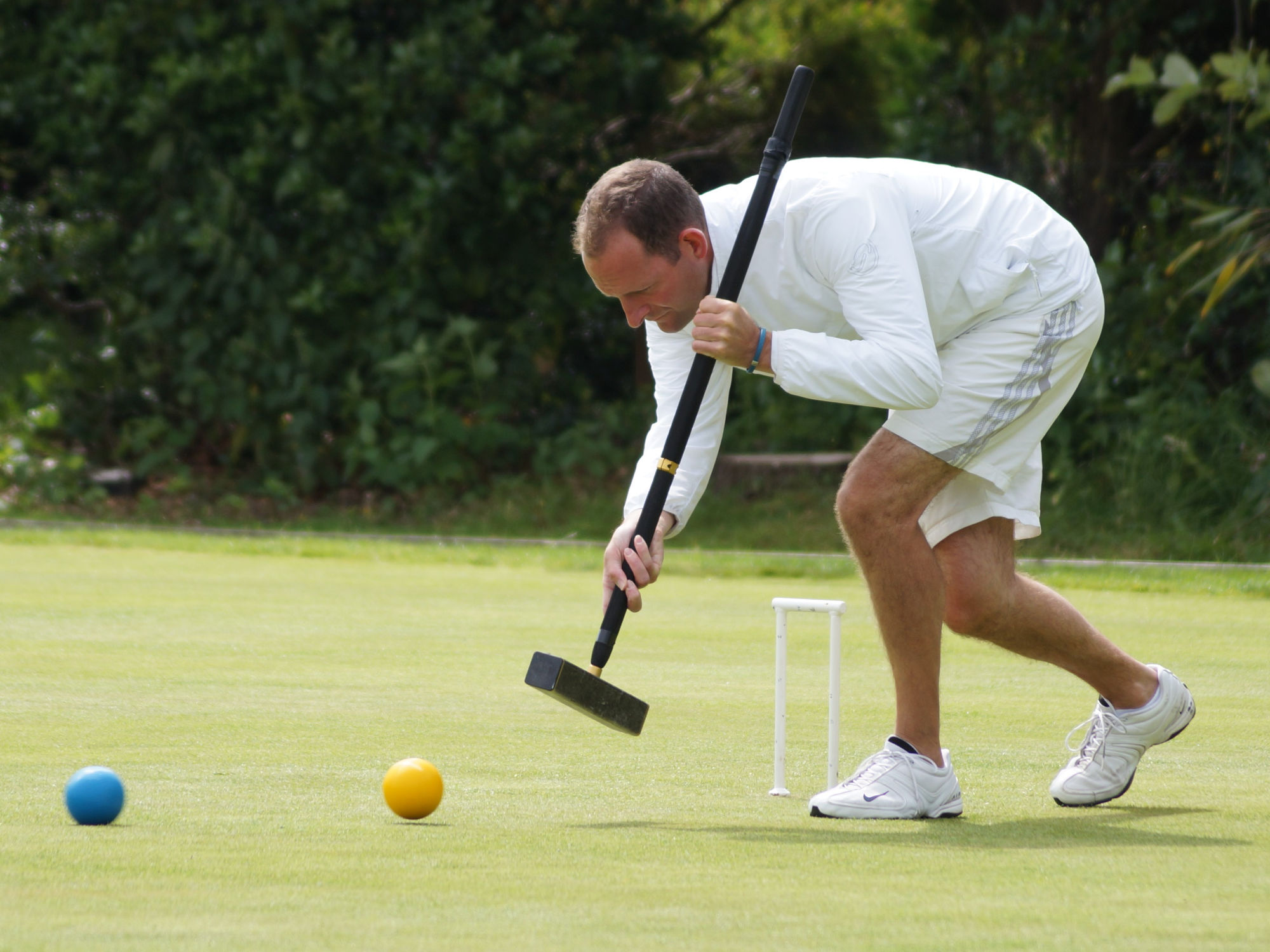
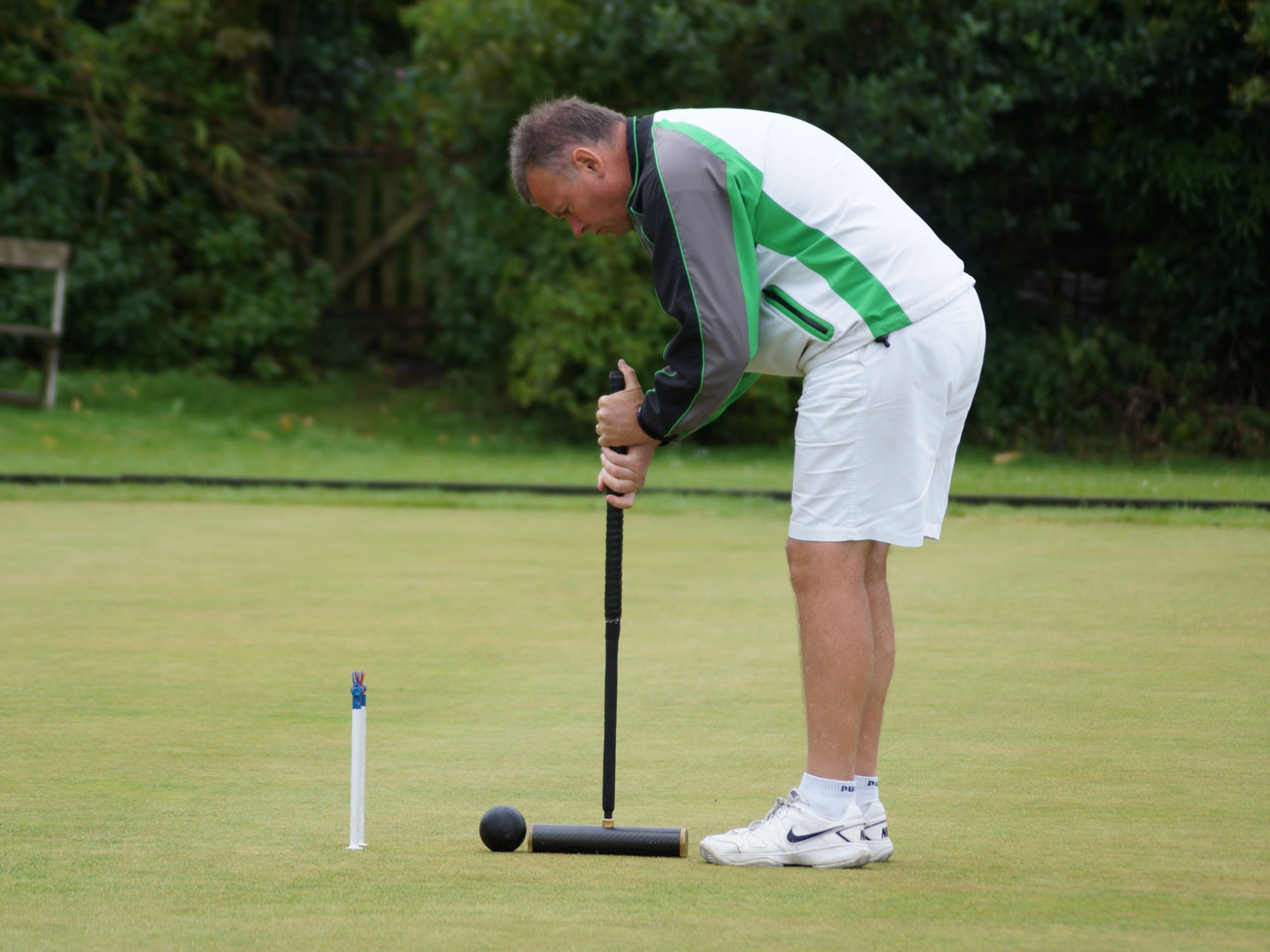
Scoring a hoop
In order to score a hoop, your ball must pass completely through it, with none of the ball visible on the playing side of the hoop. When your ball passes through its current hoop, you receive one additional stroke.
When you score the hoop and earn your additional stroke, your ball once again becomes "live" on all the other balls, meaning it can roquet each one of them again once before it has to score another hoop.
To find out more detail about the above shots, and many others, navigate to the Shots section
Utilising the other balls
As mentioned above, at the start of each turn, your ball is 'live' on all the other 3 balls – this means it is able to roquet any of them. You are only allowed to roquet each other ball once before scoring your hoop, however. When a hoop point is scored, it resets this allowance, and your ball can roquet each of the other balls once again.
By using this sequence of roquet > croquet > continuation to utilise each ball, you can look to position each of the balls around the court in a way that enables you to manoeuvre your ball through its hoops and score multiple hoops in a single turn - this is called "playing a break", just as in snooker. You are not required to use each of the other balls before running your hoop, but the more balls that you utilise, the more additional shots you will obtain. The more shots you have, the smaller (and easier) each shot can be. There is a lot more information about the different types of breaks that can be played, in the Breaks section
Turn-ending shots
Before we go any further, it's important to realise what things will cause your turn to end - these are:
- Failing your hoop
- Missing a roquet
- In a croquet stroke (2-ball stroke), sending either of the balls off the court, or not causing both balls to move when playing the stroke
Additionally, if you commit an illegal stroke (known as a "fault"), this will cause your turn to end. An example of this might be if you accidentally hit your ball twice in a single stroke. This article is not intending to cover all the various faults in detail.
Note that if you accidentally 'feather' your ball with the mallet while lining up a shot, without the intention of hitting it, this does not count as a stroke in croquet - whether a stroke is counted is all about the intent of hitting the ball - this is opposite when compared to sports like golf or snooker.
Handicap and Advanced
Handicap play
Just like in golf, every croquet player is assigned a handicap when they first start playing. A handicap is a number, and the lower it is, the more skillful a player you are. Handicaps start at 24 for an absolute beginner and go all the way down to -3 (minus 3) for the very best players in the world. Each player has a handicap card which they use to record their results, and based on wins and losses against players of different abilities, they gain and lose points, which in turn automatically adjusts their handicap. The idea behind the handicap system is to allow two players of vastly different abilities to be able to enjoy a competitive game against each other. In a handicap game, the weaker player (the player with the higher handicap) receives extra turns called "bisques" based on the difference between the two players' handicaps - for example a handicap 10 player would give 6 bisques to a handicap 16 player. A bisque is physically represented by a small white wooden stick, which is stuck into the ground (off-court). The handicap 16 player can choose to "take a bisque" at the end of their turn (signified by removing the bisque from the ground), which effectively enables them to start an additional turn from where they left off, being live on all the balls once again. An example might be if the handicap 16 player fails a hoop, or misses a roquet - taking a bisque can allow them to keep going with their turn from the current position of the balls. There is no limit to how many of their bisques the player can use in a turn. Half-bisques also exist - represented by a smaller wooden stick - where for example a handicap 1.5 player plays a handicap 6 player, the handicap 6 player will receive 4.5 bisques. Just like a full bisque, the half bisque is an extra turn, but is more limited in that no point can be scored with it.
Advanced play
Advanced play is the most common form of croquet, where players compete on equal terms and no bisques are exchanged. Instead, players compete under the same rules on both sides. Penalties called "lifts" are introduced - these are conceded when the 1-back and 4-back hoops are run. After you run either 1-back or 4-back, your opponent may begin their turn by lifting either of their balls and playing it from anywhere on either of the two baulk lines (see the court diagram further up this page). An additional penalty called a "contact" also exists if a player scores 1-back and 4-back in the same turn (if their partner ball hasn't already passed through 1-back) - a contact means that the opponent can begin their turn by lifting either of their balls and actually taking croquet from any of the other balls without having to make the initial roquet first. This usually gives the opponent a very easy start to their turn, and as a result, it is not common to see players conceding contact.

After running a lift hoop, but before ending their turn, players will normally contrive to arrange the balls in a position far away from the baulk lines, leaving the opponent no roquet shorter than 13 yards or so - called "making a leave" - and there is a whole section of the site dedicated to this.
Conclusion and next steps
Now you have a basic understanding of the sport of croquet, I encourage you to contact your nearest club to get some lessons. There is a lot more detail on the finer points of croquet elsewhere on this site, so please feel free to explore it. Use this site (and other sites) to supplement your hands-on learning.
